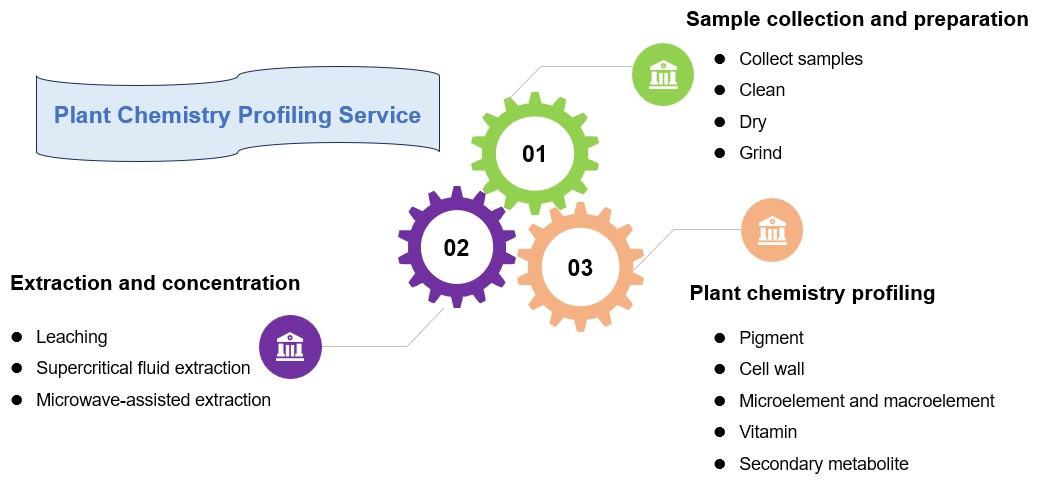Plant Chemistry Profiling Services
Various Chemistry Analysis Services in Plant at Creative Biolabs
Plant chemistry analysis is a powerful tool that provides us with a deeper understanding of biomass. Through chemical analysis of plants, we accurately understand the chemical composition of biomass, including plant pigments, vitamins, secondary metabolites, minerals, and other components. This helps evaluate the nutritional value, functional characteristics, and potential uses of biomass, providing basic data for product development. Creative Biolabs has built a mature Biomass Profiling platform, and we provide Lignocellulose Analysis, Biomass Process Liquid Analysis, plant chemistry analysis, Seaweed and Algae analysis services.
Chemical analysis of plants in biomass typically requires the following steps, each of which is a critical step:
-
Sample collection and preparation
We select representative parts of plants (such as leaves, stems, roots, etc.) to collect samples and clean the collected plant samples to avoid contamination from the external environment. The sample is then dried in a ventilated place or at a low temperature, and the dried sample is ground to obtain a uniform sample.
-
Extraction and concentration of active ingredients
We extract plant samples using appropriate solvents (e.g. ethanol, water, methanol) to isolate target compounds from the plant matrix. Extraction methods include leaching, supercritical fluid extraction, microwave-assisted extraction, etc. We then concentrate the extract to make the target compounds easier to analyze.
-
Plant chemistry profiling
We provide various types of plant pigment analysis services through high-performance liquid chromatography (HPLC), mass spectrometry (MS), and spectroscopic technologies, such as chlorophyll, carotenoids, astaxanthin, flavonoids, yellow pigments, etc.
The plant cell wall is the main component of biomass, which is composed of cellulose, hemicellulose, lignin, and other polymers. We quantitatively analyze various components of the cell wall, including total sugar, arabinose, glucose, galactose, mannose, rhamnose, xylose, lignin, starch, pectin, etc.
Biomass contains various micro and macro elements, and we process plant samples through wet, dry, and microwave digestion. Various elements in the sample are then analyzed through atomic absorption spectrometry (AAS), inductively coupled plasma emission spectrometry (ICP-OES), and inductively coupled plasma mass spectrometry (ICP-MS). Such as sodium, iron, calcium, zinc, potassium, chromium, cadmium, cobalt, etc.
Creative Biolabs has a professional scientific research team and analysis platform. We provide comprehensive analysis services for fat-soluble and water-soluble vitamins in plant samples and provide custom analysis for different sample types.
-
Secondary metabolite analysis
We provide identification and quantitative analysis for secondary metabolites (such as polyphenols, alkaloids, etc.) in biomass through chromatography-mass spectrometry (LC-MS) and other methods.
In addition, we also provide biological activity assessment services for plant extracts. If you need to inquire more about a certain analysis service, please contact us and we will respond to your needs quickly.

Published data
Bees can collect propolis from different parts of plant resins, which have been shown to have a variety of beneficial biological activities, such as antioxidant, antibacterial, and anti-inflammatory properties. The chemical composition of propolis may vary from region to region, so in this article, the authors investigated the botanical origin and chemical composition of Omani propolis. They performed silylation derivatization of propolis extract and analyzed various components in Omani propolis through GC-MS technology. The findings revealed new botanical sources of propolis, such as acacia and neem trees. 50 different types of compounds were detected in propolis extract, including sugars, polyols, hydroxy acids, fatty acids, flavonoid derivatives, terpenes, etc. In addition, the author also studied the antibacterial activity of Oman propolis samples, and the results showed that its ethanol extract had obvious antibacterial activity against Staphylococcus aureus and Escherichia coli, and had the potential to be further used as an antibacterial agent.
 Fig.1 Diverse chemical composition of Omani propolis extracts.1, 2
Fig.1 Diverse chemical composition of Omani propolis extracts.1, 2
FAQs
Q1: What techniques and methods do you typically use for plant chemistry analysis?
A1: We use advanced chromatographic analysis techniques (such as GC, HPLC), mass spectrometry analysis (such as GC-MS, LC-MS), and other spectral analysis techniques to perform plant chemistry analysis.
Q2: What is your process for processing samples? What preparations do we need to make?
A2: We need to receive representative samples and perform appropriate pre-processing such as drying and grinding as required. Specific sample preparation methods will be confirmed with you before service begins.
Q3: Are there any special requirements for how plant samples should be stored and transported?
A3: Yes, storage and transportation of plant samples are critical to analytical results. Please try to keep the sample in a constant temperature environment, avoid exposure to high temperatures or sunlight, and send it to the laboratory as soon as possible to ensure sample stability.
Customer Review
Professional Level
"The professionalism shown by the Creative Biolabs team during the plant chemistry analysis process was outstanding. Their expertise was evident in every aspect of the service. They provided me with very accurate and reliable plant chemistry analysis results, providing reliable data for my research."
Personalized Service
"Creative Biolabs's personalized approach to our plant chemistry analysis was commendable. Their ability to tailor the plant chemistry analysis to our specific needs, while efficiently processing our samples and providing timely results, earned our trust. We look forward to continued cooperation with them."
References
-
Popova, Milena, et al. "Omani propolis: chemical profiling, antibacterial activity and new propolis plant sources." Chemistry Central Journal 7 (2013): 1-8.
-
Under Open Access license CC BY 2.0, without modification.
For Research Use Only.
Related Services


 Fig.1 Diverse chemical composition of Omani propolis extracts.1, 2
Fig.1 Diverse chemical composition of Omani propolis extracts.1, 2

